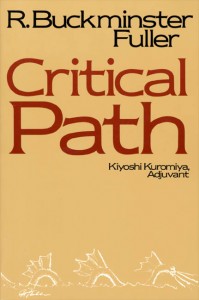Critical Path (book)

First edition
|
|
| Author | R. Buckminster Fuller |
|---|---|
| Country | United States |
| Language | English |
| Subject | history of civilization, Economic Ideology, Globalization |
| Publisher | St Martins Press |
|
Publication date
|
1981 |
| Media type | Print (Paperback) |
| Pages | 471 |
| ISBN | |
| OCLC | 8051709 |
| 909 19 | |
| LC Class | CB19 .F84 1981 |
Critical Path is a book written by US author and inventor R. Buckminster Fuller with the assistance of Kiyoshi Kuromiya. First published in 1981, it is alongside Operating Manual for Spaceship Earth one of Fuller's best-known works. Vast in its scope, it describes Fuller's own vision of the development of human civilization, economic history, and his highly original economic ideology based, amongst other things, on his detailed description of why scarcity of resources need no longer be a decisive factor in global politics.
The following is a list of the main claims and opinions presented in the book, reported without discussion or criticism.
The first part of the book explains the history and present state of the global economy.
Human life began in the atolls of the South Pacific, where the average sea temperature is closest to that of the human body (p. 6). Rather than evolving from simpler organisms, humanity was of extraterrestrial origin and other organisms evolved from us (p. 7). From this base, humanity developed boat-building in Southeast Asia and colonised the rest of the planet (p. 15). There is evidence that the Bronze Age began in Southeast Asia (p. 17). Fuller's Dymaxion World Map is used to show the distribution of humanity over the Earth's surface. Over half the population lives in the regions watered by the Himalayan glaciers (p. 20).
Our knowledge of the spherical shape of the Earth is central to our understanding of ecology (p. 34). This knowledge probably originated in prehistoric times, was certainly known to the Ancient Greeks, but was then suppressed for centuries by organised religion because it was incompatible with the official story of a Heaven above and a Hell below (p. 43). There has been an evolution of religious ideas from those of the Egyptian pyramid-builders, whose ambition was to deliver a single individual, the pharaoh, into the afterlife, to the modern belief that everybody has a right to enjoy life on Earth (p. 51).
...
Wikipedia
